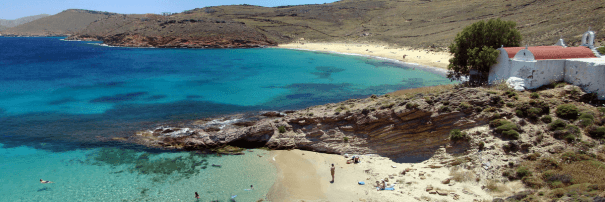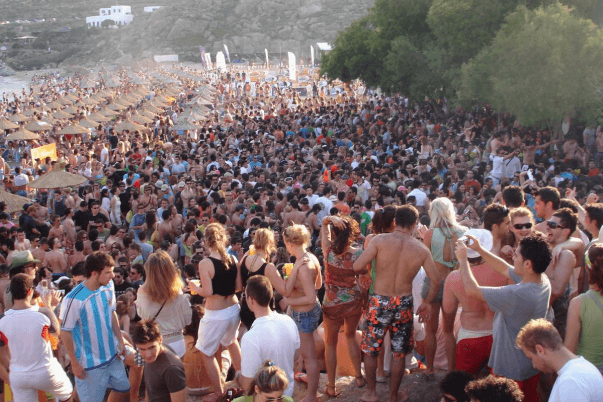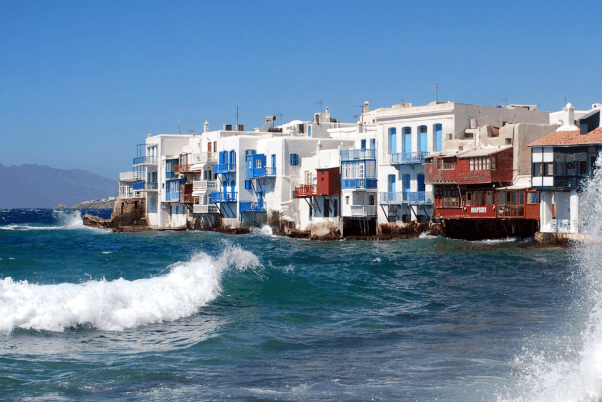If we wanted to describe in one word the glaring white set against a sunny blue backdrop amongst insuperable beaches throbbing with entertainment, it would be Mykonos. The word Mykonos is even used as a yardstick for other destinations that are trying to look like. 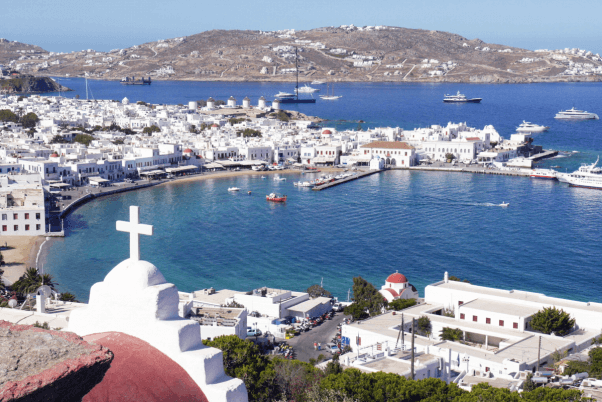 Mykonos is the quintessential Cycladic Island as it features the best in each characteristic that has to do with. Mykonos has stupendous architecture, stunning beaches, notorious nightlife, cosmopolitan flavor, celebrities that you stumble upon at any time, and an ambience of ancient glamor and tradition that goes along with modern art. But it’s this charming architecture of the cube-shaped whitewashed houses, the innumerable narrow paved maze like alleys, the hundreds of dazzling white churches and chapels that pop up in every unexpected spot, and the indolent reed-roofed windmills on the hilltops that made famous the architecture of Cyclades and glorified Mykonos as being the archetype of. Only one thing is hard to find in Mykonos: solitude! If you want to see only the other Mykonos the authentic, you should visit out of summer season. And you won’t regret it. However, even in the high season there are secluded beaches suitable for relaxation as well settlements in a calm environment such as Ano Mera which stubbornly holds the life character of traditional Cycladic village.
Mykonos is the quintessential Cycladic Island as it features the best in each characteristic that has to do with. Mykonos has stupendous architecture, stunning beaches, notorious nightlife, cosmopolitan flavor, celebrities that you stumble upon at any time, and an ambience of ancient glamor and tradition that goes along with modern art. But it’s this charming architecture of the cube-shaped whitewashed houses, the innumerable narrow paved maze like alleys, the hundreds of dazzling white churches and chapels that pop up in every unexpected spot, and the indolent reed-roofed windmills on the hilltops that made famous the architecture of Cyclades and glorified Mykonos as being the archetype of. Only one thing is hard to find in Mykonos: solitude! If you want to see only the other Mykonos the authentic, you should visit out of summer season. And you won’t regret it. However, even in the high season there are secluded beaches suitable for relaxation as well settlements in a calm environment such as Ano Mera which stubbornly holds the life character of traditional Cycladic village.
Mykonos owes its recognition as one of the most sought-after summer tourist destinations, to its neighboring island of Delos which is by itself an archaeological treasure. Originally the intellectual visitors at the archaeological site of uninhabited Delos were passing there from Mykonos and so Mykonos quickly became known for its astonishing architecture and for the best beaches of Mediterranean.  At the time a pelican settled in the port that preferred to be fed with ease by the fishermen of Mykonos rather than to migrate as nature has decided for the species of. The fishermen gave to the pelican the name Petros which soon appeared on many postcards as the mascot of Mykonos. Delos, the unique architecture, the wonderful beaches, the carefree traditional life of Mykonians and affable Petros quickly made Mykonos renowned. The influx of visitors brought the vibrant nightlife and the cosmopolitan lifestyle. Mykonos soon developed an excellent tourist infrastructure and connected with direct flights from other European countries. Mykonos now attracts the international jet set not only for their summer holidays aboard a yacht or at luxury hotel but also for acquiring vacation properties, even villas, with featured inner architectures and exterior shapes that follow the basic lines of the Cycladic architecture blending perfectly with the original architectural character of Mykonos. The whitewashed settlements with its picturesque windmills remain the dream of every artsy tourist, painter or photographer, because despite the great tourist development Mykonos has not lost its distinctive Cycladic character.
At the time a pelican settled in the port that preferred to be fed with ease by the fishermen of Mykonos rather than to migrate as nature has decided for the species of. The fishermen gave to the pelican the name Petros which soon appeared on many postcards as the mascot of Mykonos. Delos, the unique architecture, the wonderful beaches, the carefree traditional life of Mykonians and affable Petros quickly made Mykonos renowned. The influx of visitors brought the vibrant nightlife and the cosmopolitan lifestyle. Mykonos soon developed an excellent tourist infrastructure and connected with direct flights from other European countries. Mykonos now attracts the international jet set not only for their summer holidays aboard a yacht or at luxury hotel but also for acquiring vacation properties, even villas, with featured inner architectures and exterior shapes that follow the basic lines of the Cycladic architecture blending perfectly with the original architectural character of Mykonos. The whitewashed settlements with its picturesque windmills remain the dream of every artsy tourist, painter or photographer, because despite the great tourist development Mykonos has not lost its distinctive Cycladic character.
Mykonos has an exemplary public transport system with dense consistent services to almost all directions.
Mykonos Anchorages
Mykonos is generally a barren island with low hills, scant vegetation, no running waters, where arable lands are few. Mykonos is a relatively small island and it takes around 26 miles for the circumnavigation of. The coast is steep and uneven and mostly rocky. At a distance of less than a nautical mile, Mykonos is surrounded in many spots with rocks and reefs as well as some islets. In many places there are depths of less than a meter (3.28 ft) at quite some distance from coast however plenty are also the places that are suitable for anchoring a yacht rental. With a careful examination of the nautical map the appropriate spots are easily distinguished, the best though, considering also sheltering, are the following:
Mykonos Anchorages – West Coast
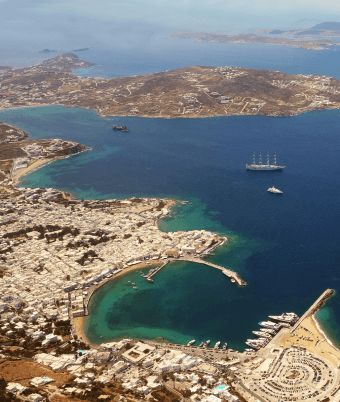 Mykonos Old Port: Located in about the middle of the western coast of Mykonos. Its shape is circular with a wide entrance to the WWS which is formed by two quayed breakwaters formed in jetties having aperture of about 170 meters. The north jetty extends to WWS for 230 meters providing protection from the north while the south jetty extends northwards for 160 meters and provides protection from the west. The port is safe from the NE to S winds while it is beaten by the N to SW winds when they are strong. Strong northerly winds are causing confused sea at the port’s entrance and a dangerous swell all over, while with the NW winds the wave height may reach 1.5 meter inside the port and up to the double outside. The bottom does not always ensure a good anchor holding and as regards the depths, it should be borne in mind that sea level may be lowered up to 15 cm when southerly winds blow while may rise up to 10 cm when northerly winds blow. The approach should be done with care because there are rocks in some places near the quayed parts. In the southeastern part of the port depths are small and suitable for fishing boats. The southern jetty features proper depths from the middle of to the north end however it is used by local coastal vessels whereas the northern jetty that also features suitable depths is used by ships in the ferry lines. The appropriate section of the port for stern-to mooring of yachts is the quayed part northeast at a length of 120 meters. For security reasons however the approach and docking of sailing yachts in this port has been banned. With easterlies and light southerlies many yachts anchor in the two small coves to the south of the port (which provide protection from east only) though caution is required in the depths for they are shallowing quickly. The scenic of the old port is of incomparable picturesqueness, however if the weather is not calm, berthing in the new port’s marina is preferable.
Mykonos Old Port: Located in about the middle of the western coast of Mykonos. Its shape is circular with a wide entrance to the WWS which is formed by two quayed breakwaters formed in jetties having aperture of about 170 meters. The north jetty extends to WWS for 230 meters providing protection from the north while the south jetty extends northwards for 160 meters and provides protection from the west. The port is safe from the NE to S winds while it is beaten by the N to SW winds when they are strong. Strong northerly winds are causing confused sea at the port’s entrance and a dangerous swell all over, while with the NW winds the wave height may reach 1.5 meter inside the port and up to the double outside. The bottom does not always ensure a good anchor holding and as regards the depths, it should be borne in mind that sea level may be lowered up to 15 cm when southerly winds blow while may rise up to 10 cm when northerly winds blow. The approach should be done with care because there are rocks in some places near the quayed parts. In the southeastern part of the port depths are small and suitable for fishing boats. The southern jetty features proper depths from the middle of to the north end however it is used by local coastal vessels whereas the northern jetty that also features suitable depths is used by ships in the ferry lines. The appropriate section of the port for stern-to mooring of yachts is the quayed part northeast at a length of 120 meters. For security reasons however the approach and docking of sailing yachts in this port has been banned. With easterlies and light southerlies many yachts anchor in the two small coves to the south of the port (which provide protection from east only) though caution is required in the depths for they are shallowing quickly. The scenic of the old port is of incomparable picturesqueness, however if the weather is not calm, berthing in the new port’s marina is preferable.
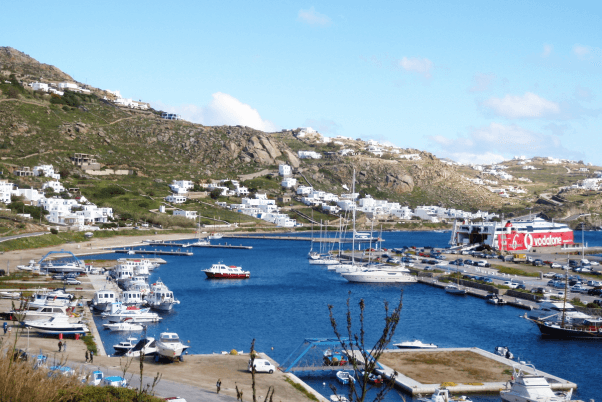 Mykonos New Port: Located at a distance of about 2 km north of the old port. It is a 700 meters length quay of NW to SE direction which is connected to the coast northerly by a 40 meters bridge forming this way an inverted T. The outer (south) side of the quay is intended for vessels of ferry lines and cruise ships. Appropriate section for the berthing of yachts is the inner (north) side of the quay at the eastern part of and generally the enclosed area which forms this section of the quay with the land. On the quay parts between the jetties of the southern section berthing is possible alongside. This area is safe at all round, but caution is needed on the squalls of N-NW winds that incommode maneuvering. The marina is a public one with water and electricity supplies while there are good restaurants within walking distance.
Mykonos New Port: Located at a distance of about 2 km north of the old port. It is a 700 meters length quay of NW to SE direction which is connected to the coast northerly by a 40 meters bridge forming this way an inverted T. The outer (south) side of the quay is intended for vessels of ferry lines and cruise ships. Appropriate section for the berthing of yachts is the inner (north) side of the quay at the eastern part of and generally the enclosed area which forms this section of the quay with the land. On the quay parts between the jetties of the southern section berthing is possible alongside. This area is safe at all round, but caution is needed on the squalls of N-NW winds that incommode maneuvering. The marina is a public one with water and electricity supplies while there are good restaurants within walking distance.
Tourlos Bay: The bay is open to the south and provides protection from northerly winds.
Korfos Bay: The bay is open to the north and provides protection from the southern up to eastern or up to western winds. The bottom is muddy with seaweed.
Positions of laid cables: Underwater cables are laid starting from the northernmost bay Choulakia and the southernmost bay Agios Ioannis of the west coast of Mykonos.
Mykonos Anchorages – South Coast
Generally all of the excellent and popular beaches of south coast are suitable to anchor and provide shelter from all winds except southerlies. Their seabed is usually sandy with seaweed and requires careful depth examination on the chart because the waters in many places are shallowing quickly.
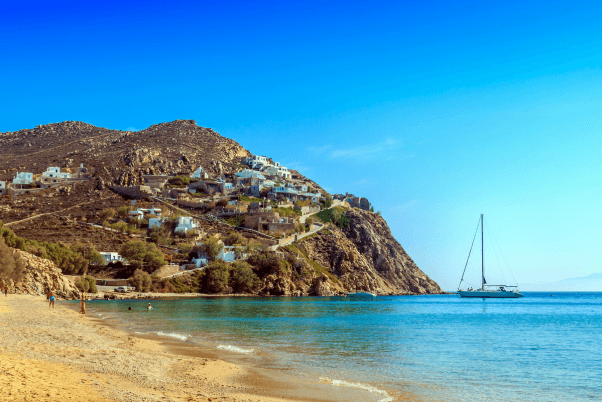 Ornos is the most sheltered bay of Mykonos providing the best protection from all winds except southerlies. Because it is connected through a flat strip of land with Korfos bay facing north, receives gusts when strong north winds blow. The bottom is sandy with seaweed and in some places does not provide good anchor holding. The bay features a dock for disembarking from dinghies as well shops, bar and tavernas. Excluding ports, it is the closest good anchorage to Mykonos Town, being just 2.8 km far off the famous windmills. This bay together with the bays Psarou and Platis Gialos receive usually most of the yachts during high season because they afford good shelter while at the same time they are close to Mykonos Town. Good protection also offers the next cove Paraga though requires more caution. Agrari affords serenity though less protection from the winds while Elia eastwards provides shelter except for SE -SW winds. Kalo Livadi whose name implies agricultural activity as indeed there are some crops on the bay environs, provides shelter apart the E-SW winds. Eastwards, the bay of Agia Anna with sandy bottom and algae is exposed only to S-SE winds though waters are very shallow. Concluding with the popular beaches of the south, the bay of Kalafatis despite that faces south is swept without resistance by the strong north winds and provides some shelter only with SW-N winds, whereas caution is needed for the reef that lies in the southern part of the bay and at a distance of approximately 175 meters (0.095 NM) both from the shore of the bay and from its south end.
Ornos is the most sheltered bay of Mykonos providing the best protection from all winds except southerlies. Because it is connected through a flat strip of land with Korfos bay facing north, receives gusts when strong north winds blow. The bottom is sandy with seaweed and in some places does not provide good anchor holding. The bay features a dock for disembarking from dinghies as well shops, bar and tavernas. Excluding ports, it is the closest good anchorage to Mykonos Town, being just 2.8 km far off the famous windmills. This bay together with the bays Psarou and Platis Gialos receive usually most of the yachts during high season because they afford good shelter while at the same time they are close to Mykonos Town. Good protection also offers the next cove Paraga though requires more caution. Agrari affords serenity though less protection from the winds while Elia eastwards provides shelter except for SE -SW winds. Kalo Livadi whose name implies agricultural activity as indeed there are some crops on the bay environs, provides shelter apart the E-SW winds. Eastwards, the bay of Agia Anna with sandy bottom and algae is exposed only to S-SE winds though waters are very shallow. Concluding with the popular beaches of the south, the bay of Kalafatis despite that faces south is swept without resistance by the strong north winds and provides some shelter only with SW-N winds, whereas caution is needed for the reef that lies in the southern part of the bay and at a distance of approximately 175 meters (0.095 NM) both from the shore of the bay and from its south end.
Positions of laid cables: Underwater cables are laid starting from the east side of Paraga cove, the east side of Bildri bight aka Super Paradise, the Elia beach, the west side of Kalo Livadi bay, and the western end of Fragia cove.
Mykonos Anchorages – North Coast
The large Panormos bay of northern Mykonos provides good shelter from southerly winds. In particular there are two remarkable, on conditions, anchorages on the east coast of the bay:
The Panormos bight which is situated in an astonishing scenic however affords shelter only with SE-NW winds.
The Agios Sostis bight provides good shelter except for NE-E winds. The approach should be carried out keeping off the rocks found north of the bight because there are reefs and shallows.
Traditional settlements of Mykonos
Mykonos Town
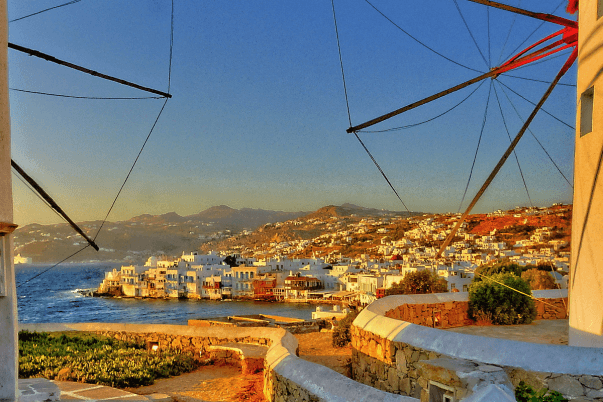 Mykonos Town (aka Chora) starts from the port and extends mainly to the south. Apart that Mykonos Town has been declared a preserved traditional settlement, the movement of vehicles inside has been also prohibited. So wandering in the labyrinthine alleys on foot, by bike or by donkey is a sedate and enjoyable travel experience.
Mykonos Town (aka Chora) starts from the port and extends mainly to the south. Apart that Mykonos Town has been declared a preserved traditional settlement, the movement of vehicles inside has been also prohibited. So wandering in the labyrinthine alleys on foot, by bike or by donkey is a sedate and enjoyable travel experience.
A famous and most photographed Mykonos Town district is the artists’ quarter, the picturesque Alefkandra. They call the “Little Venice of Mykonos” also because the waterside residences of the district are literally into the sea which splashes them all over when strong N-NW winds blow presenting a spectacular sight. Many of these residences have been converted into trendy bars that offer breathtaking views of the sunset. The district’s architecture is distinctive with the colorfulness prevailing on the windows, the doors, the stairs, the wooden balconies and the roofed verandas jutting out above the sea. These were residences of sea captains and rich merchants who started to build there from the mid-18th century. Other sources claim that these residences started being built from pirates in the 16th and 17th centuries. Characteristic point of the district is the cathedral church of Panagía Pigadiotissa on Alefkandra’s square.
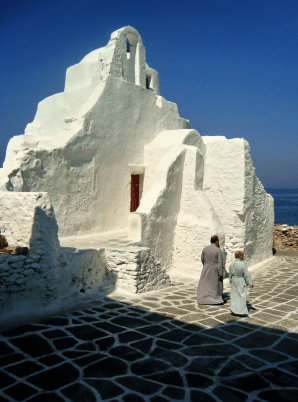 Another famous and much-photographed spot of Mykonos Town is the hillock in the area Kato Myli with six in-line windmills of the 16th century which are a part of the thirty windmills that were in use around the island for the grinding of grain. The hillock is located south of Alefkantra towards which offers striking views. In this position was the citadel of the ancient city.
Another famous and much-photographed spot of Mykonos Town is the hillock in the area Kato Myli with six in-line windmills of the 16th century which are a part of the thirty windmills that were in use around the island for the grinding of grain. The hillock is located south of Alefkantra towards which offers striking views. In this position was the citadel of the ancient city.
Interesting also are the Tria Pigadia in the namesake district, where according to legend, anyone who drinks the (brackish) water from all three wells will not ever gone from Mykonos or at least will return someday whereas if it is about a virgin she will secure a husband.
Kastro area which lies to the north after Alefkandra is the oldest part of Mykonos Town. Over there J. Gyzi built his castle in the 13th century from which nowadays there remains virtually nothing. The attraction of the area is the unusual church of Panagia Paraportiani, which is a wonderful sample of vernacular architecture and Cycladic flair, yet another unconventional artistic expression in spite of the era of slavery and destitution in which was completed. It is an amalgam of four asymmetric chapels and a fifth above, accessible via external staircase, which were built in the 15th century at the postern gate of the medieval fortress. Inside the perimeter of the aforetime castle there are 11 of the 420 churches which are estimated to exist throughout Mykonos, all of them small with no one to exceed in size the typical Mykonos home.
Ano Mera
Traditional settlement located centrally on the island, 7 km east of Mykonos Town after which is the largest settlement of Mykonos and the only one in the interior of the island. As it consists of thinly built traditional whitewashed stone farmhouses decorated with bougainvilleas and other flowers on the balconies and terraces, it does not present the characteristics of the classic compact and tangled Cycladic settlement, however well keeps the atmosphere of a traditional village. Away from the bustling and touristic Mykonos Town, the visitor in Ano Mera can watch the authentic traditional life of Mykonians and get an insight about the life of Mykonos Town inhabitants of the recent past.
The initial development of the settlement was around the monastery of Panagia Tourliani, founded in 1542. This outstanding monastery with the carved marble bell-tower and the 16th century icons embedded in the large wooden baroque altar screen carved in Florence, is dedicated to island’s protectress Virgin Mary and was renovated in 1767.
In a prominent position of the region are the ruins of the medieval castle Paleokastro, also known as Gyzi castle, which is built on the site of an ancient settlement of which are preserved parts of the city wall.
Mykonos Museums
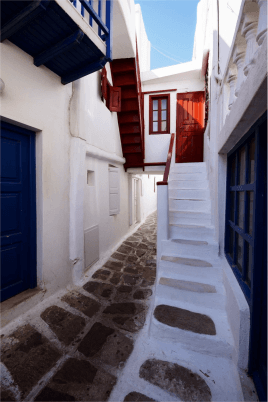 The Mykonos Folk Art Museum (tel. 22890 22591). Located in Kastro district and housed in an elegant sea captain’s manor house of the 18th century in which a part of castle’s wall is included. The museum shows the lifestyle of the inhabitants of Mykonos’ countryside and is one of the finest of its kind in Greece. It includes Mykonos’ folklore art items such as rare traditional weavings, embroidery, artifacts, furniture, ceramics, sculptures, musical instruments, old photos and an archive with historical documents. Notable is the display of a 19th-century kitchen of Mykonos. The outdoor museum area includes a dovecote, a small threshing-floor a wine press and a 16th century windmill which has been restored to full functionality.
The Mykonos Folk Art Museum (tel. 22890 22591). Located in Kastro district and housed in an elegant sea captain’s manor house of the 18th century in which a part of castle’s wall is included. The museum shows the lifestyle of the inhabitants of Mykonos’ countryside and is one of the finest of its kind in Greece. It includes Mykonos’ folklore art items such as rare traditional weavings, embroidery, artifacts, furniture, ceramics, sculptures, musical instruments, old photos and an archive with historical documents. Notable is the display of a 19th-century kitchen of Mykonos. The outdoor museum area includes a dovecote, a small threshing-floor a wine press and a 16th century windmill which has been restored to full functionality.
Mykonos Archaeological Museum (tel. 22890 22325). Located in about the middle of eastern side of Mykonos’ old port. In the halls of a beautiful neoclassical building are housed finds from Delos such as amphorae used for offerings and Kouros from the 7th century BC and also finds from the necropolis of Rhenia like vases, clay figurines, jewelry, bronze objects and grave stelae. In the chief exhibits are included the statue of Hercules from Parian marble and the large earthen jar of 7th century BC with reliefs from the campaign of the Achaeans at Troy which is an outstanding sample of archaic art.
Aegean Maritime Museum (tel. 22890 22700). Located in Tria Pigadia district at the southern part of Mykonos Town. It presents the maritime tradition of the island and the naval history of the Aegean from the pre-Minoan era to today. The exhibits include nautical instruments, nautical paraphernalia, coins from the 5th century BC with nautical themes, ship models, and paintings. The outdoor museum area includes a re-erected lighthouse.
Lena’s House (tel. 22890 22390). Located in Tria Pigadia next to the Maritime Museum. It is a completely renovated and furnished 19th century mansion where are exhibited all the objects in the life of the Mykonian Lena Sklivanou.
Mykonos Traditional Products
In Mykonos are produced excellent cheeses with leading the “piperati kopanisti” which is a spicy and creamy cheese as well the “ksinotiri” and the “tirovolia”. Its cold cuts are not inferior as in Mykonos are made excellent sausages and the known “louza”.
Excellent are also the prized confections of Mykonos like almond biscuits, “kalathakia”, etc. some of which have been commended by Winston Churchill. Worth mentioning is the refreshing drink “soumada” prepared with almond base.
Likewise in the many wineries of Mykonos are produced remarkable wines from several varieties with better-known Asyrtiko, Athiri and Aidani.
The weavings of Mykonos which were handloomed and dyed with vegetable materials were world famous. Although some are still produced in Mykonos, most of them of equally good quality, come from other parts of Greece. Well known are also the handmade leather sandals of Mykonos which are produced in many colors and designs from traditional to very modern encrusted with Swarovski crystals.
Useful Telephones in Mykonos
Port Authorities: +30-22890-22218
Police Station: +30-22890-22716
Tourist Police: +30-22890-22482
Tourist Office: +30-22890-25250
Taxi Base: +30-22890-23700 / +30-22890-22400
Public Transport: +30-22890-23360
Pharmacies: +30-22890-23151 / +30-22890-23770
Health Center: +30-22890-23994 / +30-22890-23998
Mykonos Town Community Clinic: +30-22890-22274
Ano Mera Community Clinic: +30-22890-71395

